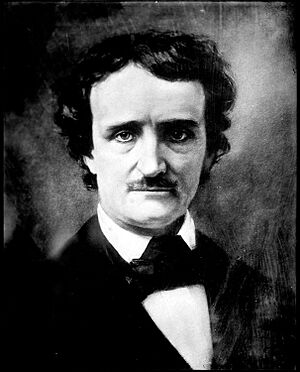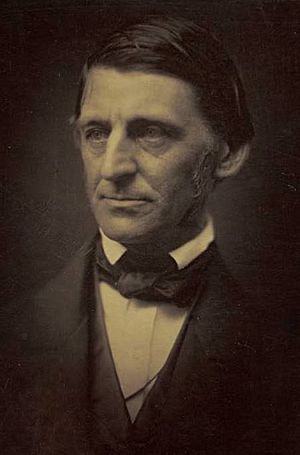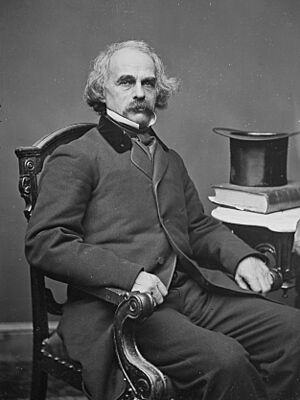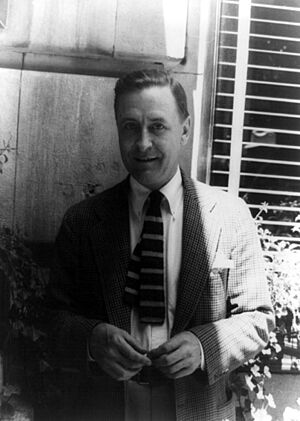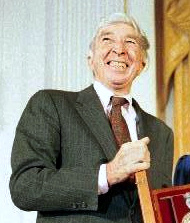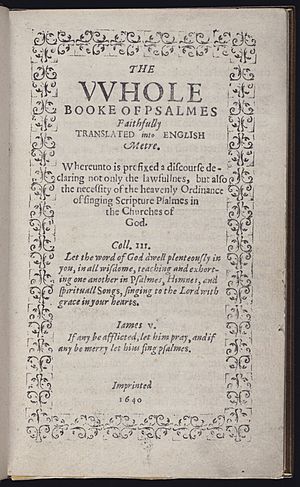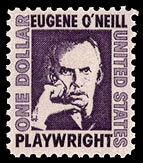Literature of the United States facts for kids
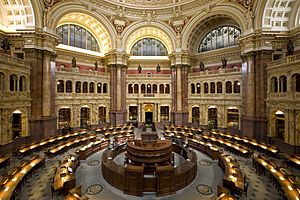
American literature means all the books, poems, and stories written in the United States and the colonies before it. Most of this literature is in English. However, it also includes writings in other languages brought by immigrants.
Native American tribes also have a long history of oral storytelling. This means they passed down stories by telling them aloud.
After the American Revolution (1775–1783), important political writings appeared. Thinkers like Benjamin Franklin and Thomas Jefferson wrote about freedom. One of the first American novels was The Power of Sympathy (1791).
Later, writers like Edgar Allan Poe explored new ideas in poetry and short stories. Ralph Waldo Emerson started a movement called Transcendentalism. This idea encouraged people to connect with nature. Henry David Thoreau, who wrote Walden, was part of this group.
The fight against slavery also inspired many writers. Harriet Beecher Stowe wrote Uncle Tom's Cabin. Former slaves like Frederick Douglass shared their powerful life stories.
Famous 19th-century authors include Nathaniel Hawthorne (The Scarlet Letter) and Herman Melville (Moby-Dick). Poets like Walt Whitman and Emily Dickinson changed how poetry was written. Mark Twain was a major writer from outside the East Coast.
After World War I, writers experimented with new styles. F. Scott Fitzgerald captured the exciting 1920s in The Great Gatsby. Ernest Hemingway and William Faulkner used unique writing forms. Poets like T. S. Eliot and Robert Frost became well-known.
During the Great Depression, John Steinbeck wrote about hard times in The Grapes of Wrath. World War II also inspired books like Catch-22. Playwrights like Eugene O'Neill became famous.
Today, American literature is very diverse. It includes works by immigrant, Native American, and LGBT writers. Authors like Toni Morrison (who won a Nobel Prize) and Louise Erdrich are celebrated. Even musician Bob Dylan won the Nobel Prize for Literature!
Contents
- Native American Stories
- Early American Literature
- After Independence
- 19th Century: A Unique American Style
- Late 19th Century: Realism
- 20th Century Prose
- After World War II
- Modern Fiction
- Poetry
- Drama
- Diverse Voices in American Literature
- Nobel Prize Winners from America
- American Literary Awards
- Images for kids
- See also
Native American Stories
Native American literature has a rich history. It comes from many different tribes across the country.
Stories Told Aloud
Before Europeans arrived, Native American tribes had many oral stories. These stories were not written down. They were passed from generation to generation by speaking and listening. Each tribe had its own unique culture and stories.
First Published Books
The first book by a Native American in English was published in 1771. It was a sermon by Samson Occom. In 1854, John Rollin Ridge wrote The Life and Adventures of Joaquin Murieta. This was the first novel by a Native American author.
A big moment for Native American literature came in 1969. N. Scott Momaday won the Pulitzer Prize for his novel House Made of Dawn. This helped bring more attention to Native American writers.
Early American Literature
Early American literature often came from the first European settlements. While English became the main language, other languages like Spanish and German were also used.
The first book printed in Pennsylvania was in German! There were also many oral stories from Native American tribes.
In the early days, printing was not common in the colonies. London printers often published works by New England authors. This meant that American literature was bigger than what was printed in America itself.
Some early American writings were pamphlets. They talked about the benefits of living in the colonies. Captain John Smith wrote some of the first American books. These included A True Relation (1608) and The Generall Historie of Virginia (1624).
Early Writings: What They Were About
Early American literature often focused on religion. John Winthrop wrote The History of New England. This book talked about the religious reasons for starting the Massachusetts Bay Colony. Other religious writers included William Bradford. He wrote a journal about the first years of the Plymouth Colony.
Some writers, like Roger Williams, argued for separating church and state. Others, like Thomas Morton, even made fun of the Puritans. Morton said Native Americans were better people than the Puritans.
Later writings described conflicts with Native Americans. John Eliot translated the Bible into the Algonquin language in 1663. This was the first complete Bible printed in North America.
Cotton Mather was a famous writer from the second generation of settlers. He wrote about the colonies' history from a religious viewpoint. His book Magnalia Christi Americana (1702) connected Puritan leaders to Christian heroes.
The First Great Awakening in the 1700s was a religious revival. Writers like Jonathan Edwards were part of this movement.
Literature also grew in the Southern colonies. William Byrd II wrote a diary and The History of the Dividing Line (1728). This book described the land and the differences between Native Americans and white settlers.
As the colonies moved towards independence, people started thinking about American identity. J. Hector St. John de Crèvecœur wrote Letters from an American Farmer (1782). He asked, "What is an American?"
This time also saw the start of African-American literature. Phillis Wheatley was an early poet. Olaudah Equiano wrote a famous story about his life as a slave.
Writings During the Revolution
The Revolutionary period had many important political writings. Benjamin Franklin's Poor Richard's Almanack was full of wisdom. His The Autobiography of Benjamin Franklin is still popular today.
Thomas Paine's pamphlets, Common Sense and The American Crisis, were very important. They helped convince colonists to fight for independence.
During the American Revolutionary War, poems and songs were popular. Writers like John Trumbull wrote satires.
In the 18th century, writing changed. It moved from religious topics to ideas based on reason. People started believing that the human mind could understand the universe. This period was called the American Enlightenment. It led to more democratic ideas.
The population grew a lot, leading to more different opinions. This diversity showed up in literature. Benjamin Franklin's Autobiography became very popular.
After Independence
After the war, Thomas Jefferson became a key figure. He wrote the United States Declaration of Independence. He also influenced the U.S. Constitution.
The Federalist Papers were important essays by Alexander Hamilton, James Madison, and John Jay. They explained how the American government should work.
Early American novels tried to find their own style. They often copied European books. But critics usually thought the American versions were not as good.
The First American Novels
The first American novels were published in the late 1700s and early 1800s. More people were learning to read, so publishers hoped these books would sell well.
The Power of Sympathy (1789) by William Hill Brown was one of the first. It told a sad love story.
Charles Brockden Brown wrote gothic novels like Wieland (1798). These books were full of mystery and suspense.
Washington Irving was the first writer to earn a living just from his books. He wrote humorous works like A History of New-York (1809).
Other notable authors included James Fenimore Cooper. He is famous for The Last of the Mohicans (1826). This book was about life on the American frontier.
Omar ibn Said, a Muslim slave, wrote his autobiography in Arabic in 1831. This was an early example of African-American literature.
19th Century: A Unique American Style
After the War of 1812, Americans wanted their own unique literature. Writers like Washington Irving and James Fenimore Cooper helped create this. Cooper's Leatherstocking Tales were popular in America and Europe. They told stories about American life.
John Neal was a critic who pushed for American writing to be different. He said American writers should not copy British styles.
Edgar Allan Poe was a master of short stories. He wrote dark and mysterious tales like "The Fall of the House of Usher". Poe also invented the detective story with "The Murders in the Rue Morgue".
Humorous writers were also popular. They wrote about life on the American frontier.
In New England, a group called the Fireside Poets became famous. They included Henry Wadsworth Longfellow.
In 1836, Ralph Waldo Emerson published Nature. He believed people could find spiritual truth by connecting with nature. His ideas led to Transcendentalism.
Henry David Thoreau, Emerson's friend, was also a Transcendentalist. He lived simply by a pond and wrote Walden (1854). This book encouraged people to resist society's rules.
The fight against slavery also inspired many writers. Harriet Beecher Stowe's Uncle Tom's Cabin (1852) was a very influential book. It showed the horrors of slavery.
Nathaniel Hawthorne wrote "romances" (novels) that explored themes like guilt. His most famous work is The Scarlet Letter (1850). It is set in Puritan Massachusetts.
Herman Melville wrote adventure stories based on his time at sea. His masterpiece, Moby-Dick (1851), is about a man's obsession with a white whale. It explores ideas about evil and human struggle.
These writers, along with Poe, are sometimes called "Dark Romantics." They explored the darker side of human nature.
Diverse Voices in the 19th Century
Slave narratives continued to be important. Frederick Douglass wrote Narrative of the Life of Frederick Douglass, an American Slave (1845). Harriet Jacobs wrote Incidents in the Life of a Slave Girl (1861).
Native American authors also published their stories. William Apess wrote A Son of the Forest (1829).
Minority authors began writing fiction. William Wells Brown wrote Clotel (1853), one of the first African-American novels. John Rollin Ridge's The Life and Adventures of Joaquín Murieta (1854) was an early story about Mexican-American issues.
Late 19th Century: Realism
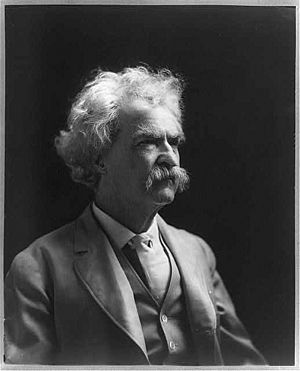
Mark Twain (born Samuel Langhorne Clemens, 1835–1910) was one of the first major American writers not from the East Coast. He grew up in Missouri.
His famous books include Life on the Mississippi, The Adventures of Tom Sawyer, and Adventures of Huckleberry Finn (1884). Twain's writing style was new. He used everyday language and regional accents. His characters sounded like real Americans.
Other writers focused on regional differences and dialects. They wrote about specific parts of America.
William Dean Howells was a leader in the realist movement. His novels, like The Rise of Silas Lapham (1885), showed life as it really was.
Henry James (1843–1916) lived mostly in England. Many of his novels are about Americans visiting or living in Europe. His stories often explore emotional and psychological details. Daisy Miller (1878) is a good starting point.
Stephen Crane (1871–1900) is known for his Civil War novel The Red Badge of Courage (1895). Other writers, like Hamlin Garland, wrote about the problems faced by American farmers.
Social Novels
Some novels in this period focused on social issues. Edward Bellamy's Looking Backward (1888) was a utopian novel. It explored ideas for a better society.
20th Century Prose
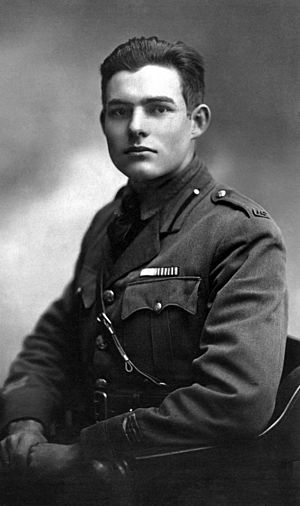
In the early 1900s, American novelists wrote about all kinds of life. Edith Wharton (1862–1937) wrote about upper-class society. Her book The Age of Innocence (1920) is a great example.
Some writers focused on social issues and big corporations. Upton Sinclair's The Jungle (1906) exposed problems in the meatpacking industry. Jack London also wrote about social justice.
Race was another important topic. Pauline Hopkins wrote influential works about African-American experiences. Sui Sin Far wrote about Chinese-American life.
Writers like Willa Cather wrote about the Midwest and West.
The 1920s: A New Era
The 1920s brought big changes to American literature. Many writers had experienced World War I. This influenced their writing.
Some American writers, like Gertrude Stein and T. S. Eliot, lived in Paris. They were part of the "Lost Generation". They helped American literature become more international.
F. Scott Fitzgerald (1896–1940) captured the mood of the 1920s, which he called the "Jazz Age". His most famous book, The Great Gatsby, shows how golden dreams can lead to disappointment.
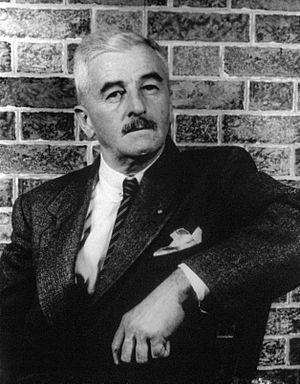
Ernest Hemingway (1899–1961) wrote in a simple, direct style. He believed that fancy words could be misleading. His best novels include The Sun Also Rises and A Farewell to Arms. He won the Nobel Prize in Literature in 1954.
William Faulkner (1897–1962) won the Nobel Prize in 1949. He created his own fictional county in Mississippi. He used a technique called "stream of consciousness". This showed his characters' inner thoughts. His books include The Sound and the Fury.
The 1930s: Depression Era
Literature during the Great Depression often criticized society. John Steinbeck (1902–1968) wrote about poor, working-class people. His masterpiece, The Grapes of Wrath (1939), tells the story of a family moving to California for a better life. He won the Nobel Prize in Literature in 1962.
Other popular novels by Steinbeck include Of Mice and Men.
After World War II
Novels
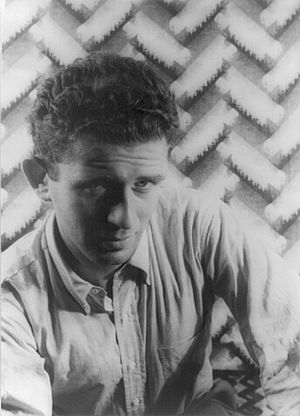
After World War II, novels explored personal, racial, and ethnic themes. The war itself was the subject of books like Norman Mailer's The Naked and the Dead (1948) and Joseph Heller's Catch-22 (1961).
Saul Bellow became a very important American writer. His books, like The Adventures of Augie March (1953), showed Jewish life in America. He won the Nobel Prize in 1976.
Other famous novels from this time include J.D. Salinger's The Catcher in the Rye (1951). To Kill a Mockingbird (1960) by Harper Lee was a popular novel about racial inequality.
The "Beat Generation" emerged in the 1950s. This group of writers, like Allen Ginsberg, explored rebellion and new spiritual ideas.
John Updike wrote about American middle-class life. His "Rabbit" series of novels, starting with Rabbit, Run (1960), explored everyday challenges. He won the Pulitzer Prize for Fiction twice.
Philip Roth often wrote about Jewish identity in America. His books, like American Pastoral (1997), are known for their fast-paced style. He won many major literary awards.
In African-American literature, Ralph Ellison's Invisible Man (1952) was very important. It explored racial tension in America. Richard Wright's Native Son (1940) was also a powerful book.
Short Stories
The short story form also became popular after the war. Flannery O'Connor wrote unique "Southern gothic" stories. Her stories often had deep religious themes. Other important short story writers included John Cheever and Raymond Carver.
Modern Fiction
Since the 1990s, a style called postmodernism has been important. Thomas Pynchon is a key writer in this style. His books, like Gravity's Rainbow (1973), are complex and often use humor.
Toni Morrison won the Nobel Prize in Literature. Her novels, like Beloved (1987), use a lyrical style. They often explore themes of history and magic. Beloved won the Pulitzer Prize for Fiction.
Cormac McCarthy writes in a powerful, flowing style. His books often explore the American West or dark themes. Blood Meridian (1985) is a famous example. His novel The Road (2007) won the Pulitzer Prize.
Don DeLillo writes about modern American life. His novel White Noise (1985) looks at death and consumerism. His book Underworld (1997) is considered his masterpiece.
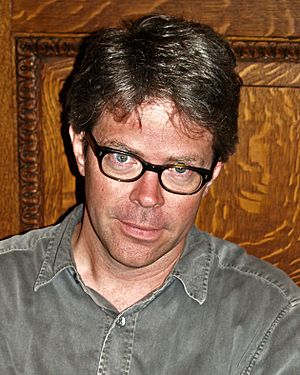
David Foster Wallace wrote complex and humorous books. His novel Infinite Jest (1996) is about a future America.
Jonathan Franzen is another important writer. His novel The Corrections (2001) won the National Book Award. It is a funny and sad story about a family.
Other notable modern writers include Michael Chabon (The Amazing Adventures of Kavalier & Clay) and Louise Erdrich (The Round House).
Poetry
Early American poetry was very religious. The Bay Psalm Book (1640) was one of the first poetry books published. It contained translations of biblical Psalms.
Important early poets included Anne Bradstreet. She wrote personal poems about her family. Edward Taylor wrote poems to help him prepare for worship.
18th Century Poetry
In the 18th century, poets started writing more about America itself. Philip Freneau (1752–1832) wrote poems that showed sympathy for Native Americans. However, much of this poetry was still influenced by European styles.
19th Century Poetry
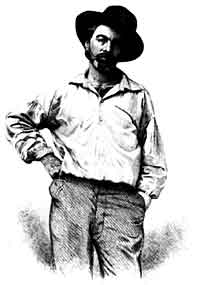
The Fireside Poets were some of America's first famous poets. They included Henry Wadsworth Longfellow. Their poems were easy to remember and often recited in homes and schools. They wrote about American themes, including political issues like slavery. Longfellow was the first American poet to have a bust in Westminster Abbey.
Walt Whitman (1819–1892) and Emily Dickinson (1830–1886) were two of America's greatest 19th-century poets. They were very different. Whitman was a traveler and a nurse during the American Civil War. His main work, Leaves of Grass, used a free-flowing style. It celebrated American democracy and everyday life.
Emily Dickinson lived a quiet life. Her poetry was clever and deep. It was unusual for her time, and most of it was not published until after her death. Many of her poems are about death, often with a playful twist.
20th Century Poetry
American poetry reached a high point in the early to mid-20th century. Famous poets included Wallace Stevens, T. S. Eliot, and Robert Frost.
T. S. Eliot (1888–1965) wrote complex and symbolic poetry. His poem The Waste Land showed a dark view of society after World War I. He won the Nobel Prize in Literature in 1948.
After World War II Poetry
After World War II, many respected American poets emerged. These included John Ashbery, Elizabeth Bishop, and Richard Wilbur.
Louise Glück won the Nobel Prize in Literature. Her poems often explore themes of truth and doubt.
The "Confessional" and "Beat" poetry movements also became popular. Poets like Allen Ginsberg and Sylvia Plath were part of these groups.
Drama
American theater started in the 1700s. But American plays became internationally famous in the 1920s and 1930s. This was thanks to Eugene O'Neill. He won four Pulitzer Prizes and the Nobel Prize in Literature.
Early American plays often copied European styles. But they used American topics like immigrants or westward expansion. They also created famous American character types.
Realism began to influence American plays. This meant plays tried to show life more accurately.
In the mid-20th century, American drama was led by Tennessee Williams and Arthur Miller. The American musical also became very popular. Musicals like Oklahoma! combined story, music, and dance.
Later important playwrights include Edward Albee and August Wilson.
Diverse Voices in American Literature
In the late 20th century, literature by and about ethnic minorities grew. This happened alongside the Civil Rights Movement. Universities started programs to study these new types of literature. This also included women's literature and LGBT literature.
Ethnic Literature
The second half of the 20th century saw many important Jewish American writers. These included Saul Bellow and Philip Roth.
Asian American literature also became widely known. Maxine Hong Kingston wrote The Woman Warrior (1976). Ha Jin won the National Book Award for his novel Waiting.
Other notable Asian-American novelists include Amy Tan (The Joy Luck Club). Jhumpa Lahiri won the Pulitzer Prize for Fiction for her short stories, Interpreter of Maladies (1999).
Hispanic literature also became important. Sandra Cisneros is famous for her novel The House on Mango Street (1983). Rudolfo Anaya wrote Bless Me, Ultima.
Dominican-American author Junot Díaz won the Pulitzer Prize for Fiction for The Brief Wondrous Life of Oscar Wao (2007). Julia Alvarez is known for How the García Girls Lost Their Accents.
Puerto Rican writers like Giannina Braschi and Rosario Ferré also gained fame. Lin-Manuel Miranda, a Nuyorican poet, created the popular musical Hamilton.
Native American literature saw a big growth, called the Native American Renaissance. Writers like Leslie Marmon Silko (Ceremony) and Louise Erdrich (Love Medicine) became well-known.
More recently, Arab American literature has become more prominent. Diana Abu-Jaber is a notable author in this area.
Nobel Prize Winners from America
Here are some American authors who have won the Nobel Prize in Literature:
- 1930: Sinclair Lewis (novelist)
- 1936: Eugene O'Neill (playwright)
- 1938: Pearl S. Buck (biographer and novelist)
- 1948: T. S. Eliot (poet and playwright)
- 1949: William Faulkner (novelist)
- 1954: Ernest Hemingway (novelist)
- 1962: John Steinbeck (novelist)
- 1976: Saul Bellow (novelist)
- 1978: Isaac Bashevis Singer (novelist, wrote in Yiddish)
- 1987: Joseph Brodsky (poet and essayist)
- 1993: Toni Morrison (novelist)
- 2016: Bob Dylan (songwriter)
- 2020: Louise Glück (poet)
American Literary Awards
Many awards celebrate American literature:
- Pulitzer Prize (for Fiction, Drama, Poetry, and more)
- National Book Award (for Fiction, Non-Fiction, Poetry, and Young-Adult Fiction)
- American Book Awards
- United States Poet Laureate
- Bollingen Prize
- Pushcart Prize
- O. Henry Award
Images for kids
-
Captain John Smith's A True Relation (1608) is considered America's first work of literature.
- American literature (academic discipline)
- Great American Novel
- List of American literary critics
- List of 20th-century American writers by birth year
Regional and Minority Literature
- Literature of New England
- Chicago literature
- Southern literature
- Literature in Hawaii
- LGBT literature
- Deaf American literature
- American Catholic literature
- American literature in Spanish
- Ethnic minority literature
- Armenian American literature
- African-American literature
- Jewish American literature
- Arab American literature
- Asian American literature
- Latino literature
See also
 In Spanish: Literatura de Estados Unidos para niños
In Spanish: Literatura de Estados Unidos para niños


